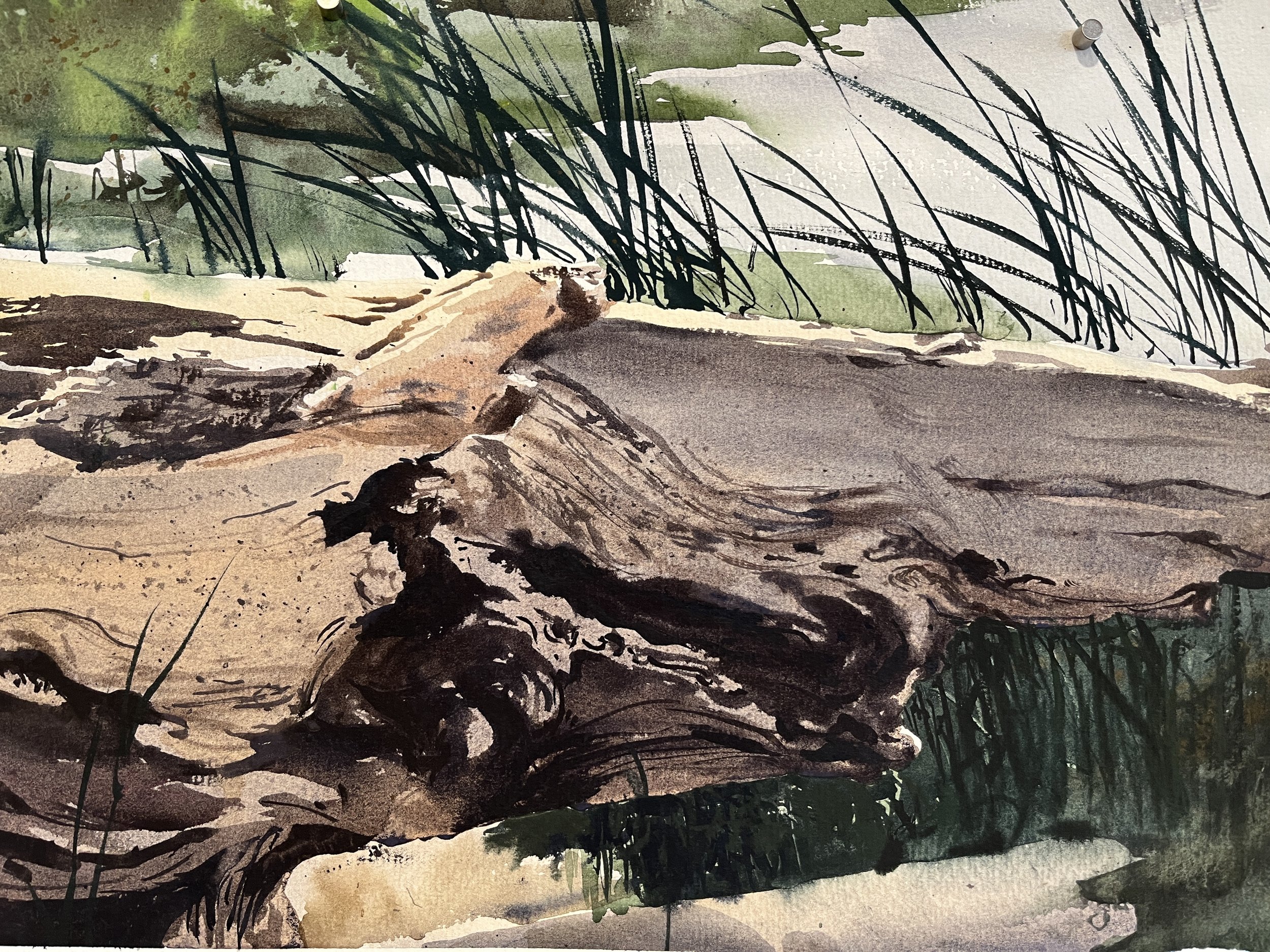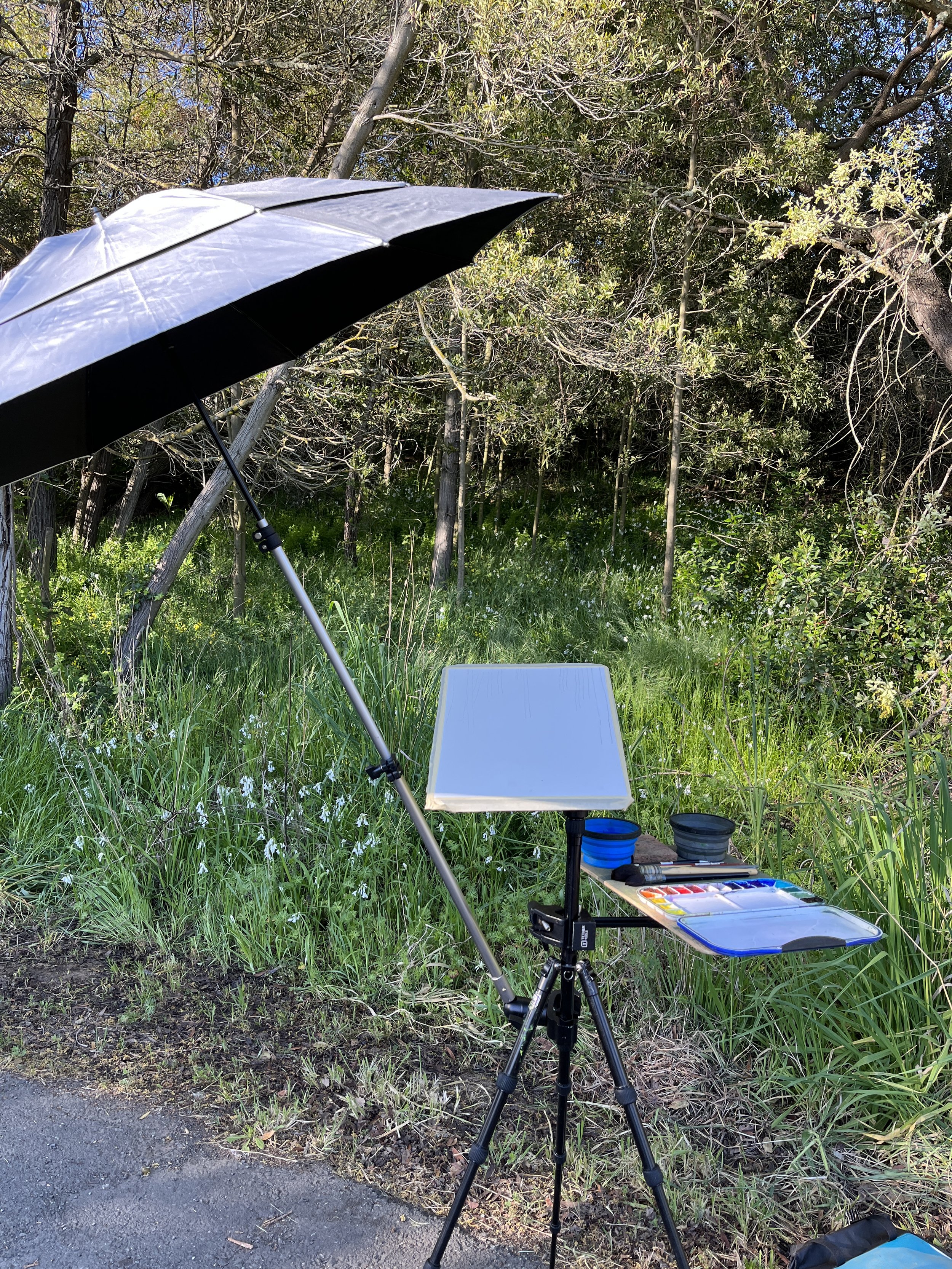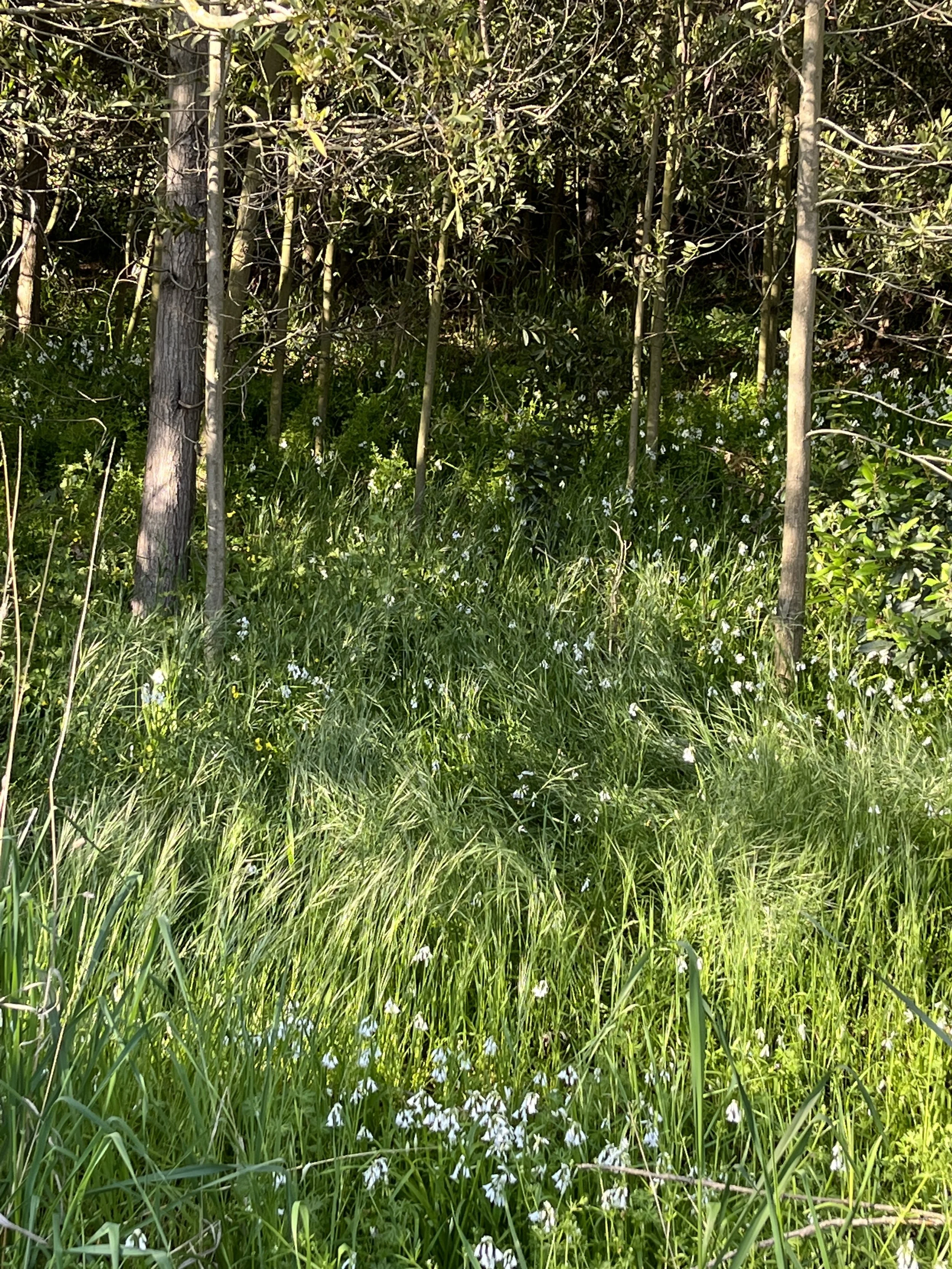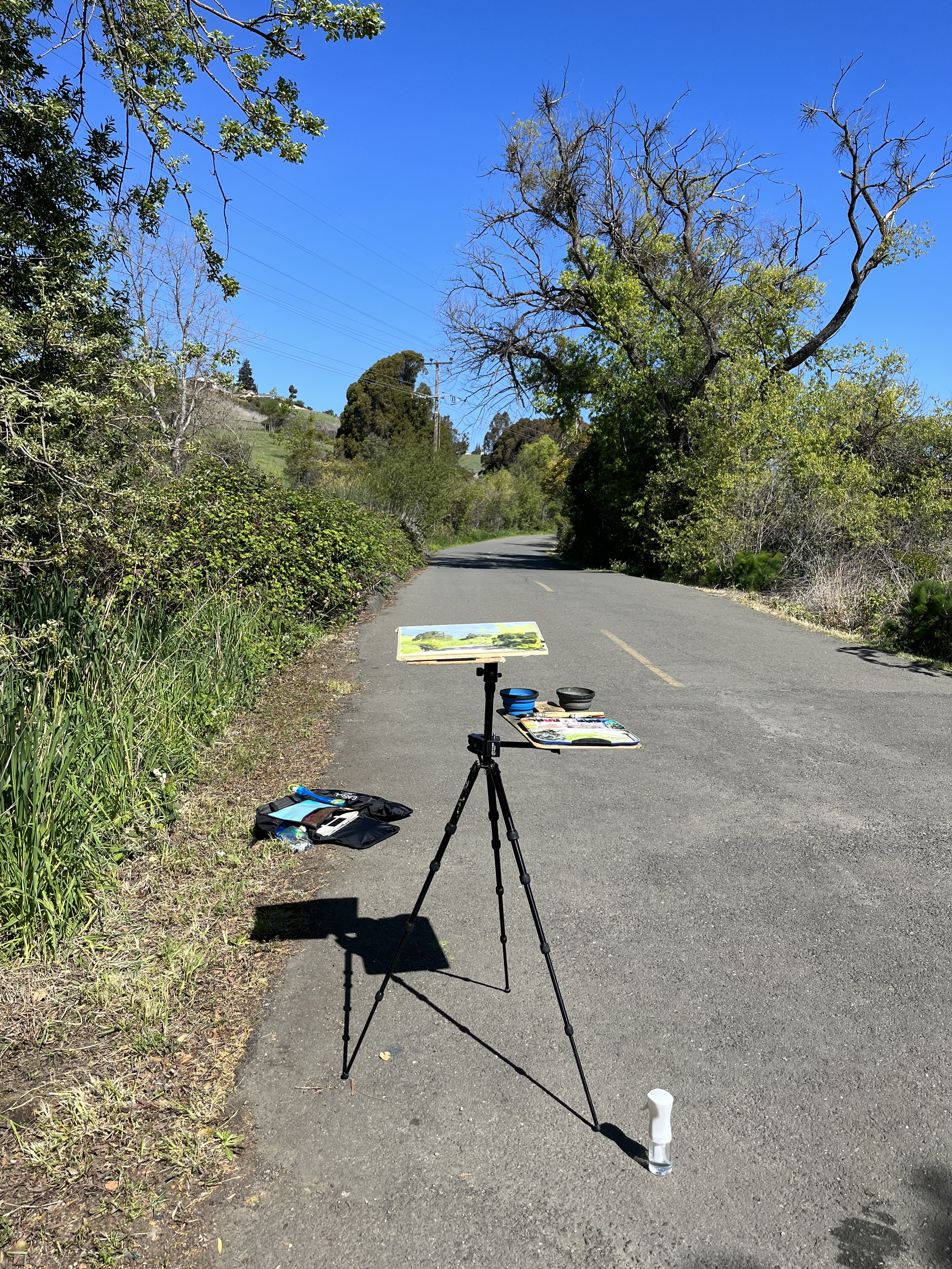Getting Back into Plein Air
Things are finally drying out and warming up around here in Northern California, so I got out the other day to do some plein air painting for the first time this year. Every time I get back in to painting plein air after many months off, I find I have to go through the same re-learning process. There’s always a gearing up phase where I have to teach myself the same lessons over and over. This Spring has been no different. :P
First Lesson- Bring All Your Supplies!
I went out this past Monday. I was so sure of myself, double checking everything the night before (see? I’ve learned from past mistakes!). Paper? Check. Masking tape? Check. Pencil? Check. Brushes? Check. I had everything packed up and headed out early, at 715. I did a 3.5 mile roundtrip hike (which was lovely), and what did I forget? My paints. LOL!!! It happens to all of us. One time I forgot all my brushes too.
You learn as you go, and when I’m painting plein air more consistently I have little systems set up that keep things running smoothly. In the past, I’ve made a checklist that I keep as a note on my phone. This year, for the first time, I’ve also created a dedicated plein air bag. I actually went through the expense of setting up a second set of paint tools- brushes, collapsible cups, sponge, rag, backing, and tripod, etc. It was a bit of a pain, but now I have a sort of “go bag” for plein air. The only thing I didn’t get around to duplicatin? My paints. Sheesh!!
Second Lesson- Dress Appropriately
On Tuesday, I did my first painting. This time I brought my paints. Huzzah! I was determined to paint, dammit! :D
Driftwood, 4/18/23
I forget how cold it can be when painting in the morning. I didn’t dress appropriately and was quite cold. I hiked around, but the protected nature of this little cove is really what dictated my subject. The wind was up elsewhere. It’s amazing what having a hat, a sweater, and a vest can do. I missed mine.
I also didn’t bring my umbrella. About 3/4 of the way through, it got sunny and I wished I had it. Sun can really drain you, even when you’re not doing much. It can also really dry out your paints and paper!
Third Lesson- Choose a Subject You Can Simplify!
I went back out on Thursday and tried again. I found this cute little spot when I went out hiking on the first day- the day I forgot my paints. :P Looking at it here, it’s hard to say why, but this view intrigued me. Looking into the little glen, with the white wild onions blooming there, I liked the idea of things moving from shadow into sunlight. But once I got going, about an hour in, I knew I’d made a mistake.
I’d forgotten this (as I seem to do almost every year), but often, after having not painted plein air for some extended length of time, I have a difficult time choosing on-site subjects for a while. Painting complex subjects like this are often much easier in the studio, where you can control lots more variables— multiple washes, using a blow dryer, how humid it is, taking a break and coming back later, etc. Even more important, in the studio certain compelling effects of passing light can be held in place, static in a reference photo.
However, choosing a plein air subject based on passing cast shadows and lighting is a surefire way to elevate your frustration. Things are changing far too fast. I’ve actually had the (rather stupid and frustrating) experience of painting from a photo on my phone, while literally standing in front of a spot, plein air— all because I didn’t choose my subject wisely. So, you’ve got to choose your shapes wisely or you can get trapped halfway through a painting, working from a composition of light and shadow that no longer exists.
In the field, the bones of the scene need to be much stronger. Stacked shapes need to read dark versus light, and they need to stay that way. I have to track the sun and think about where it’s going to be in an hour or so. Ephemeral cast shadows can be interesting, but they’re like seasoning in a stew when working plein air. They can’t be your whole subject.
For this one, I didn’t even finish the piece. After a painstaking hour and a half, I knew I’d made a mistake, and shut down work on it. It was a painting better saved for a day at home.
Lesson Four- Find or Make Shade
After the last disappointing experience, I was ready to go home, but I just wanted to do a little sketch that I felt was less ambitious but might atleast lead to some success. I turned to my right, and saw the strong shapes of this bank of trees, the long cast shadow that I knew would be there for quite a while given where the sun was, a clear arrangement of dark versus light stacked shapes, and a nice little focal point where folks were coming around the bend. I decided to go for it.
I smashed out a quick painting in an hour, which was fine. But I really wished I’d arranged things with my umbrella, or shifted over to the shade of a tree. The paper in this light was drying super quick, and it made things much harder than it needed to be. It was at this point that I remembered that the way it should really work, when painting plein air, is to find where you’re going to set up first (where you know there will be adequate shade for an adequate amount of time, or where you can properly arrange your umbrella), and then hunt for subjects from that vantage point. The issue here was that it’s hard to get the umbrella to shade the paper if the sun is also on my right- my palette shelf gets in the way.
Anyways, I got a little sketch in that I felt was pointing me in the right way.
Next week, I’ll go out again, and I think I’ll have things under better control. Atleast I hope so! Ugh. Sometimes I wonder why artists put themselves through this plein air process. LOL.
I think there’s lots to learn from it. Most of all, I find painting plein air really forces you to- A) pay attention, B) to simplify and C) to create a hierarchy of importance. Often, when painting in the studio, it’s easy to endlessly paint and fill a canvas up with info that doesn’t necessarily matter very much. The logistical difficulties of plein air really push you to you better assess things before you begin.
All of this frustration, and the general feeling of ridiculousness, like making a faux pas with an old friend after having not seen them for a long time, made me go back to this old post that I did when painting plein air for the Sonoma Plein Air Festival in 2020. From it, I bring you (and, honestly, myself too) the list of things I learned over the course of that week. It kills me that the top three on it are the same mistakes I made this last week!! :P
Art Rules I Tell Students That I Should Follow Too—
1) Pick a spot in the shade and out of the sun. If there’s not shade, make some.
2) Pick a subject with strong shapes. If your shapes aren’t strong, make them so.
3) Paint value-shapes, not shadow and light. Don’t get caught “chasing the light”. Stack your shapes if you can.
4) Paint smaller than you think you should. It makes everything easier.
5) Slow down and don’t freak out. Other beautiful moments will appear after you’re prepared and are ready to paint.
6) Be your own guide. Draw a notan. Sketch with a pencil on your canvas.
7) Have a plan. Having a notan or a sketch helps you get acquainted with your subject.
8) Simplify.
9) When painting wet into wet, finish one section before you move on to the next. Shrink your scope.
10) Save 10%+ to finish at home, where you can judge your painting on it’s own
Good luck! I hope some of you get out painting too. :)








